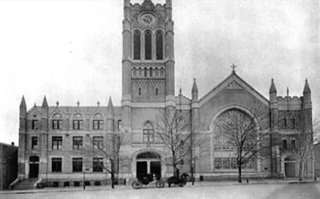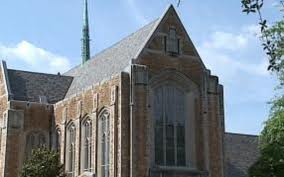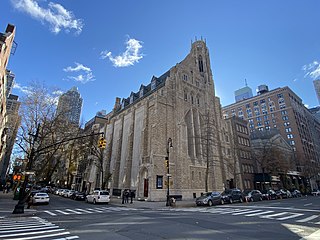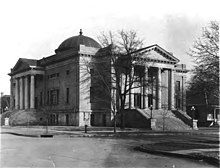
The Presbyterian Church (USA), abbreviated PC (USA), is a mainline Protestant denomination in the United States. It is the largest Presbyterian denomination in the country, known for its liberal stance on doctrine and its ordaining of women and members of the LGBT community as elders and ministers. The Presbyterian Church (USA) was established with the 1983 merger of the Presbyterian Church in the United States, whose churches were located in the Southern and border states, with the United Presbyterian Church in the United States of America, whose congregations could be found in every state.

The Cumberland Presbyterian Church is a Presbyterian denomination spawned by the Second Great Awakening. In 2019, it had 65,087 members and 673 congregations, of which 51 were located outside of the United States. The word Cumberland comes from the Cumberland River valley where the church was founded.
Charles William Kerr was an American Presbyterian minister from Pennsylvania who served as pastor of First Presbyterian Church in Tulsa, Oklahoma from 1900 to 1941. Kerr was the first permanent Protestant Christian pastor to serve in Tulsa. He led the church through dramatic growth and change resulting from the discovery of oil in this area.
Tulsa is the second-largest city in the state of Oklahoma and 45th-most populous city in the United States.

The First Presbyterian Church in Chattanooga, Tennessee, located at 554 McCallie Avenue, is a historic, downtown congregation of the Presbyterian Church in America (PCA) and the first Christian congregation founded in Chattanooga.

Shadyside Presbyterian Church is a large congregation of the Presbyterian Church (U.S.A.) in an historic part of Pittsburgh, Pennsylvania, United States. Located at the corner of Amberson Avenue and Westminster Place in the Shadyside neighborhood, Shadyside Presbyterian Church was founded in 1866 as a congregation in the Presbyterian Church in the U.S.A. and has enjoyed a long history of local, national, and global recognition for its outreach and service.

The congregation of North Presbyterian Church, at 525 West 155th Street in Manhattan, New York City, is a combination of three former congregations: North Presbyterian Church, Washington Heights Presbyterian Church, and St. Nicholas Avenue Presbyterian Church.

Old Kingsport Presbyterian Church is an historic church located in Kingsport, Tennessee. The church was organized May 20, 1820 as the Boatyard Congregation. It is the oldest one of any denomination in the city of Kingsport. It is a member of the Presbyterian Church (U.S.A.).
The Rennie Memorial Presbyterian Church is a Presbyterian Church congregation in Amelia, Virginia, US. It was established on April 23, 1950 and sits on grounds that were previously occupied by the Amelia Presbyterian Church.

James Monroe Hall (1851–1935) came to the town of Tulsa in what was then known as Indian Territory. James and his brother, Harry C. Hall, operated a tent store that had followed the route of the Atlantic and Pacific Railroad and selected the site where the road would stop at Tulsa. They initially selected a site where the railroad crossed what would become Lewis Avenue and pitched a tent for the store there. This location was just inside the boundary of the Cherokee nation. When the Halls discovered that the Creek Nation had less restrictions on the activities of white merchants, they moved the store a couple of miles west to what would become First Street and erected a more permanent wooden building.

Mount Zion Baptist Church is a historically significant church in the Greenwood District of Tulsa, Oklahoma. It was listed on the National Register of Historic Places on September 5, 2008. The original building was burned during the Tulsa race massacre on June 1, 1921. According to the Tulsa Preservation Commission, "... Mount Zion Baptist Church remains a testimony to the perseverance and tenacity of its congregants and the black community in Greenwood." The church building was rebuilt in 1952 on its original site.

Independent Presbyterian Church is a congregation of the Presbyterian Church (U.S.A.) located on the Southside in Birmingham, Alabama. Initially started by a group of 25 following controversy over doctrinal issues within a local congregation, the church now has approximately 1800 members.

First Presbyterian Church in Schenectady, New York is a historic Presbyterian Church in America congregation.

First Presbyterian Church is a historic Presbyterian congregation in Hattiesburg, Mississippi, founded in 1882 by Rev. A. B. Coit. It was the first church in the town and predated Hattiesburg's own incorporation by two years. In 1973 it left the Presbyterian Church in the United States to become a charter member of the more theologically conservative Presbyterian Church in America.

The First Presbyterian Church is a church in the Museum District of Houston, Texas. As of 2012 it had 3,567 members. The church has been located in the Museum District since 1948.

Central Presbyterian Church is a historic congregation on the Upper East Side of Manhattan in New York City, founded by pastor and abolitionist William Patton in 1821. It is a member of the Evangelical Presbyterian Church, and it worships in a Gothic Revival structure completed in 1922 that was originally commissioned and largely funded by John D. Rockefeller Jr. as Park Avenue Baptist Church.

Jamaica First German Presbyterian Church is a historic Presbyterian church in the Jamaica neighborhood of Queens in New York City.



















